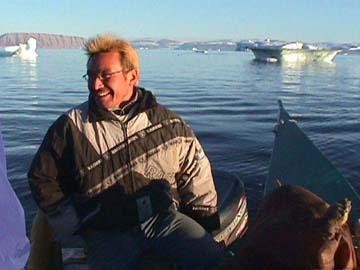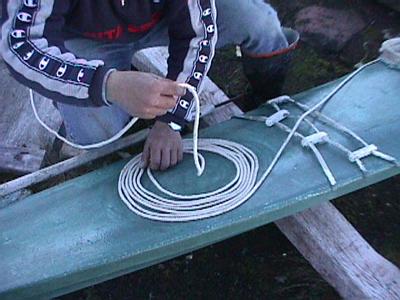20 August, 2000
We awoke to a beautiful sunny Sunday morning, but our fishing equipment
still hadn't arrived in Thule. We decided to attend church. We were all
amazed how the congregation harmonized. It was as if they had been
practicing four part harmony for years. After the service the minister
kindly let me take pictures. The painting of Jesus with two small Inuit
children above the alter was the same painting I later saw in old black and
white photos of the Thule trading post church and so I think it had probably
been moved from old Thule village.
We returned to the Alderhous for lunch and found that that they were
celebrating the opening of an art show that afternoon. The artist is a Dane
named is Gitz Johansen. He is very famous in Denmark and Greenland for his
depiction of life at Thule during the late 30's. His son has returned to
Qaanaaq with a number of paintings to present a museum quality exhibit at
the Alderhous. Some of the older people residing here remember his father
well and himself as a young child. The celebration included some drum
chanting by people in the community. As one person sings and pats the drum,
another holds a small white tube in front of the person. When another
person wants to sing the tube and drum are exchanged. I later asked Navarana
K'Avigak", one of the singers, why the tube? I was told that it had been
forgotten why. A guess is that it was used to keep the singer from singing
for too long a time, she laughed.
Later that afternoon we went to the water to await Mads Ole, who said he
would take us on a narwhal hunt after showing Dr. Radtke and Josh the inlet.
While waitng for his arrival, we walked along the beach finding red
jellyfish, rocks with small garnets in them, and ice that had floated up to
lodge in the sand. When he arrived Anderson, Wendy, and I exchanged places
with Dr. Radtke and Josh. It was a tight squeeze as the kayak was also on
board with us. We traveled along Hvalsund (Ikerssuaq) and into Bowdoin Fjord
where the narwhal feed. Narwhal are a relatively small whale, a male being
around 6 meters with a long horn protruding 2-3 meters out of its head. It
is said that when the Vikings saw the cut off horns they thought they had
discovered the place where unicorns lived.
We pulled the boat onto the shore and went up to the hunter's hut. I bumped
my head twice going into the cabin as the door way was about a meter high;
inside we started the primus stove and were warm in an amazing short time.
We ate a meal of dried narwhal, which tasted like fish jerky, with biscuits,
granola bars, and spicy jerky from the states. After trading some phrases
among our three languages--Greenlandic, Danish, and English we went back
outside to explore. We found many narwhal bones bleaching in the sun and I
watch as Mas Ole prepared his kayak for the hunt. He put a seal skin inside
where he sits and then coiled a rope on the front of his kayak. One end was
attached to a swim bladder made out of a seal's skin and the other to his
harpoon. The paddles were very narrow so he could move quietly through the
water. If he spotted a narwhal in the fjord he would paddle as close as he
could with his kayak to harpoon it. Then he would follow the swim bladder
until the narwhal surfaced again, possible 25 minutes, to shoot it with his
rifle.
He watched the water patiently as the afternoon progressed; large icebergs
passed with a quickness belying their size from the glaciers inside the
fjord. But we only saw two seals swimming and feeding and so we returned to
Qaanaaq and made plans for the following day. Dr. Radtke decided that Mas
Ole and I should travel tomorrow to Lake Tassersuit by boat to catch fish
with the gill net. I am excited about the prospect of finally seeing the
study sight and to have the opportunity to experience more of the life style
here in this beautiful place.

Water color by Gitz-Johansen.

Looking out over Bowdoin Fjord.

Mas Ole Kristiansen; notice his kayak on the boat beside him.

Lunch in the hunter's hut.

Coiling the rope for the harpoon.

The kayak is ready. Notice the harpoon to the left, the swim bladder at the front and the narrow paddle along the right side.

Contact the TEA in the field at
.
If you cannot connect through your browser, copy the
TEA's e-mail address in the "To:" line of
your favorite e-mail package.
|
